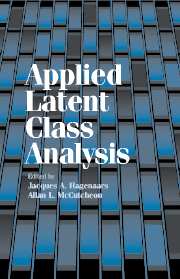Book contents
- Frontmatter
- Contents
- Contributors
- Preface
- INTRODUCTION
- CLASSIFICATION AND MEASUREMENT
- 3 Latent Class Cluster Analysis
- 4 Some Examples of Latent Budget Analysis and Its Extensions
- 5 Ordering the Classes
- 6 Comparison and Choice: Analyzing Discrete Preference Data by Latent Class Scaling Models
- 7 Three-Parameter Linear Logistic Latent Class Analysis
- CAUSAL ANALYSIS AND DYNAMIC MODELS
- UNOBSERVED HETEROGENEITY AND NONRESPONSE
- Appendix A: Notational Conventions
- Appendix B: Further Readings
- Appendix C: Selected Software; Webpage
- Index
6 - Comparison and Choice: Analyzing Discrete Preference Data by Latent Class Scaling Models
Published online by Cambridge University Press: 31 July 2009
- Frontmatter
- Contents
- Contributors
- Preface
- INTRODUCTION
- CLASSIFICATION AND MEASUREMENT
- 3 Latent Class Cluster Analysis
- 4 Some Examples of Latent Budget Analysis and Its Extensions
- 5 Ordering the Classes
- 6 Comparison and Choice: Analyzing Discrete Preference Data by Latent Class Scaling Models
- 7 Three-Parameter Linear Logistic Latent Class Analysis
- CAUSAL ANALYSIS AND DYNAMIC MODELS
- UNOBSERVED HETEROGENEITY AND NONRESPONSE
- Appendix A: Notational Conventions
- Appendix B: Further Readings
- Appendix C: Selected Software; Webpage
- Index
Summary
INTRODUCTION
One of the major difficulties in the analysis of preference data is accounting for individual taste differences in the comparison and evaluation of different choice options. Presenting an extension of classical latent class analysis, this chapter demonstrates that latent class scaling models offer a general solution to this problem. Latent class scaling models simultaneously identify subgroups with homogeneous preferences and provide a graphical representation of the similarity structure underlying the choice options. Several applications involving “pick any/J,” as well as (in) complete and partial ranking data, are discussed that illustrate the versatility of latent scaling class models in the analysis of different types of choice data.
The main reason for the versatility of Lazarsfeld's (1950) latent class (LC) model is its underlying assumption that the latent variables are categorical and nominal. No restrictions are imposed on relationships among the latent classes and the nature of the manifest variables within each latent class with the exception of conditional independence. It is therefore not surprising that extensions of the LC model focused almost exclusively on the introduction of constraints to facilitate the applicability of an LC model to particular research problems. This chapter is concerned with applications in which many individuals choose among a set of items. Responses may be expressed in the form of approvals, ratings, or (incomplete and partial) rankings.
- Type
- Chapter
- Information
- Applied Latent Class Analysis , pp. 163 - 182Publisher: Cambridge University PressPrint publication year: 2002
- 4
- Cited by



